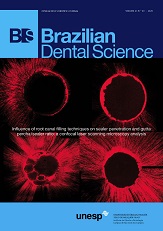Influence of the addition of glass fibers reinforcements in the flexural strength of acrylic resin
DOI:
https://doi.org/10.14295/bds.2020.v23i3.1955Abstract
Objective: To evaluate the influence of glass fiber reinforcements used in nautical and sports products on the flexural strength of acrylic resin. Materials and methods: Thirty thermoactivated acrylic resin bars (25 x 10.5 x 3.3 mm) were used. The samples were shared in 3 groups: bars with no glass fiber (control group, n = 10), bars reinforced with glass fiber and 0.18 mm thickness (group F1, n = 10) and bars reinforced with glass fiber and 0.80 mm thickness (group F2, n = 10). After 48 hours, samples were submitted to compression test in order to evaluate flexural strength. Obtained data were statistically analyzed with significance level of 5 %. Results: It was observed that the use of glass fiber effectively increased the flexural strength compared to the control group; the thickness of the glass fiber, however, did not present statistical differences. Conclusion: The use of fiber glass is a simple and cost-effective alternative to improve acrylic resin performance.
Keywords
Flexural strength; Water sports; Dentures.
Downloads
References
Gad MM, Fouda S M, Al-Harbi F A, Napankangas R, Raustia A. PMMA denture base material enhancement: a review of fiber, filler, and nanofiller addition. Int J Nanomedicine. 2017 May 17;12:3801-12.
Murthy HBM, Shaik S, Sachdeva H, Khare S, Haralur SB, Roopa KT. Effect of Reinforcement Using Stainless Steel Mesh, Glass Fibers, and Polyethylene on the Impact Strength of Heat Cure Denture Base Resin – An In Vitro Study. J Int Oral Health 2015 Jun;7(6):71-79.
Uctasli M B, Arisu H D, Lasila L V, Valittu P K. Effect of Preheating on the Mechanical Properties of Resin Composites. Eur J Dentistry. 2008 Oct;2:263-268.
Monaco C, Arena A, Scotti R and Krejci I. Fracture Strength of Endodontically Treated Teeth Restored with Composite Overlays withand without Glass-fiber Reinforcement. J Adhes Dent. 2016;18(2):143-9.
Fonseca R B, Almeida L N, Mender G A M, Kasuya A V B, Favarão I N, Paula M S. Effect of short glass fiber/filler particle proportion on flexural and diametral tensile strenght of a novel fiber-reinforced composite. J Prosthodont Res. 2016 Jan;60(1):47-53.
Jeganathan S and Lin C C (1992). Denture stomatitis – a review of the aetiology diagnosis and management. Australian Dental J. 1992 Apr; 37:107-114.
Wambua P, Ivens J, Verpoest I. Natural fibres: can they replace glass in fibre reinforced plastics? Composites Science and Technology 2003 Jul;63:1259-64.
Ansell MP. Natural fibre composites in a marine environment. Materials, processes and applications 2014;365-74.
Uzun G, Hersek N, Tinçer T. Effect of five woven fiber reinforcements on the impact and transverse strength of a denture base resin. J Prosthet. Dent 1999 May; 81(5):616- 20.
Li BB, Xu JB, CUI HY, Lin Y, Di P. In vitro evaluation of the flexural properties of All-on-four provisional fixed denture base resin partially reinforced with fiber Dent Mater J 2016;35(2):264-9.
Goguţă LM, Bratu D, Jivănescu A, Erimescu R, Mărcăuţeanu C. Glass fibre reinforced acrylic resin complete dentures: a 5-year clinical study. Gerodontology 2012;29(1):64-9.
Miranda JS, Marinho CC, Macedo VC, Barcellos ASP, Paradella TC, Paes Jr TJA, Kimpara ET. Braz Dent Sci 2018;21(2):150-6.
Berger G, Pereira LFO, Souza EM, Rached RN. A 3D finite element analysis of glass fiber reinforcement designs on the stress of an implant-suported overdenture. JPD 2019;121(5):865.e1-e7.
Mattheus FL, Rawlings RD. Composite materials: Engeneering and Science. Woodhead Publishing Limited, Champman & Hall,2008.
Downloads
Published
How to Cite
Issue
Section
License
Brazilian Dental Science uses the Creative Commons (CC-BY 4.0) license, thus preserving the integrity of articles in an open access environment. The journal allows the author to retain publishing rights without restrictions.
=================




























